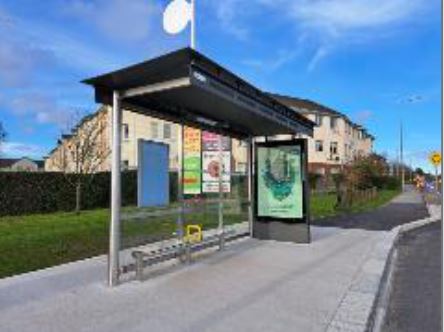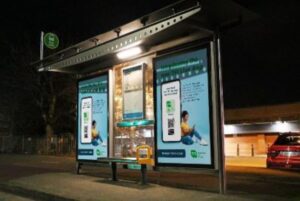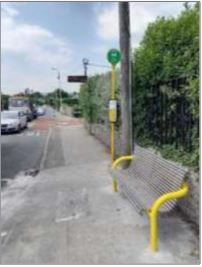The BusConnects Dublin Programme includes construction of enhanced bus stops and shelters across Dublin to align with the redesigned network and Core Bus Corridors. The new style of TFI (Transport for Ireland) bus stops can be seen below. This design provides a modern and consistent look across the Public Service Obligation (PSO) fleet, and is intended to reinforce the integrated nature of the PSO services, allowing passengers to more easily identify these services alongside other commercial operations.
Along the 12 Core Bus Corridors, enhanced bus stops, most to be equipped with bus shelters and real time passenger information signs, will be provided as part of the construction of the individual corridors. Along the other sections of the new bus network, new TFI bus poles are being installed in tandem with the roll-out of the different phases of that network.
The NTA’s standard design of bus stop (in locations where there is no bus shelter) now consists of a high-visibility green and yellow flag incorporating a pictogram of a bus and text that typically shows the route numbers serving the stop, the operator of each route number and the unique identification code for that stop.
The pole is fabricated from stainless steel to maximise longevity and eliminate the need for repainting, but can also be easily replaced if necessary owing to its placement in a socket within the pavement rather than directly into the ground as was common in the past. The pole is also fitted with a carousel to display service information and positioned at a height to ensure that there is universal access to it. The yellow plastic forming the carousel is designed to ensure that the carousel is high-visibility, and together with the yellow on the flag, ensures that the bus stops are prominent and distinctive within the urban environment which was a key request from accessibility stakeholders, in particular those with a visual impairment.
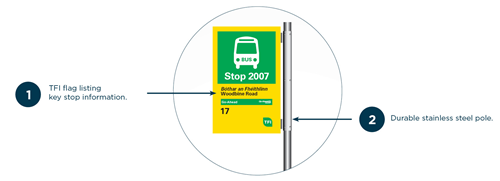
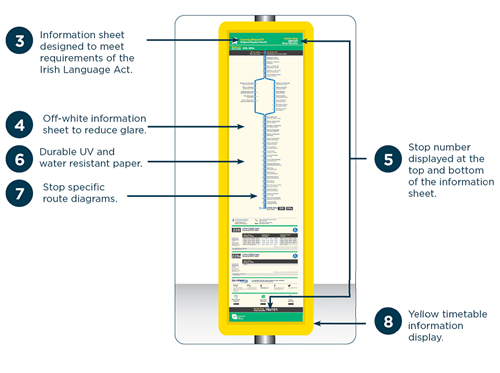
TFI bus pole and flag design
Bus Shelters
Bus shelter design has also evolved since the designs that were familiar to passengers during the 1980s and 1990s, with more vandal-resistant, maintainable and aesthetically-pleasing designs being installed more in more recent times. During 2023, the NTA began working with its bus shelter supplier to develop a prototype of a simplified standard shelter design, to improve passenger experience, rationalise supply and installation costs, simplify the sourcing of materials (change over from steel to aluminium) and the installation processes and achieve reductions in the current timeframe required to install each shelter.
Bus Shelter Illumination Programme
In 2021, the NTA commenced a programme of research work with its bus shelter contractor into the enhancement of the level of illumination at bus shelters in order to achieve a consistent and satisfactory lighting level within all bus shelters. This arose, in large part, from a change in the power supply for bus shelters, and their disconnection from general public lighting supplies due to regulatory constraints.
By the end of 2023, solar-powered courtesy lighting systems had been installed by the NTA at 844 bus
shelter locations, along with larger solar-powered courtesy lighting plus advertising panel systems at a
further 50 bus shelter locations, meaning that 894 out of the 943 bus shelter locations that were
without an electricity supply from the grid or the public lighting system across the country now have
sufficient illumination.
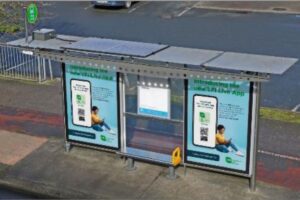
Solar-powered courtesy lighting system installed on roof of bus shelter with battery pack (at far left) and solar panel (left of centre)
Bus Stop Seating and High-Visibility Armrest Retrofit Programmes
All seating units that are being installed as part of the bus shelter retrofit programme, and indeed all seating units being provided at all new bus shelter installations, have been designed to meet the requirements of IS EN:17210 Accessibility and Usability of the Built Environment.
In addition, a high-visibility armrest retrofit programme has seen a large number of high-visibility yellow armrests retrofitted to existing seating units at bus shelter locations, to bring the accessibility features of these more into line with the latest seating units being installed.
Once these programmes have been completed, consideration will be given to the replacement of existing perch style seating at other older bus shelters.
Bus Stop Enhancement Programme
As part of its 2024 Capital Investment Programme, the NTA has initiated a “Bus Stop Enhancement Programme” across all local authorities, with an allocation of €500,000 to each local authority as part of the 2024 allocations. The objective of this programme is to facilitate the enhancement / upgrade of existing bus stops to the meet the NTA’s minimum requirements for passenger experience. It is intended to repeat this as an annual funding stream for a number of years, to enable and facilitate the necessary uplift and enhancements to bus stop locations across the country.
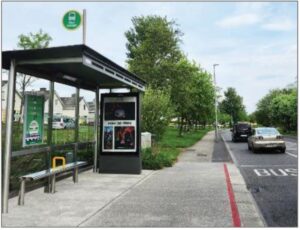
Bus shelter equipped with the latest design of seating unit, incorporating high-visibility yellow armrest

